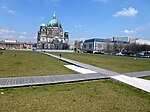Neuer Marstall

The Neuer Marstall (English: New Stables) is a listed historic building in Berlin, Germany located on the Schloßplatz and the Spree River. Completed in 1901 and facing the former Royal Palace, the neo-Baroque "New Stables" once sheltered the Royal equerry, horses and carriages of Imperial Germany. The complex also included three enclosed courtyards, a riding school, and the Knights College. At the end of World War I, this was where revolutionaries hatched plans that brought down the Hohenzollern dynasty during the German Revolution of 1918–1919. Severely damaged in World War II, the building was partially repaired in the 1960s and used as an exhibition space for the Berlin Academy of Arts. After more renovations in 2005, the building became the home of the Hanns Eisler Academy of Music and the Berlin City Library. More restoration work has continued since 2007. Lonely Planet lists the Neuer Marstall at number 79 in their 815 "things to do" in Berlin.
Excerpt from the Wikipedia article Neuer Marstall (License: CC BY-SA 3.0, Authors, Images).Neuer Marstall
Spreeufer, Berlin Mitte
Geographical coordinates (GPS) Address External links Nearby Places Show on map
Geographical coordinates (GPS)
| Latitude | Longitude |
|---|---|
| N 52.516769444444 ° | E 13.403683333333 ° |
Address
Neuer Marstall
Spreeufer
10178 Berlin, Mitte
Germany
Open on Google Maps









